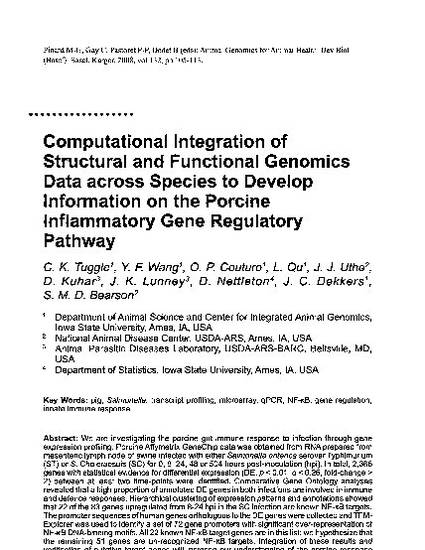
We are investigating the porcine gut immune response to infection through gene expression profiling. Porcine Affymetrix GeneChip data was obtained from RNA prepared from mesenteric lymph node of swine infected with either Salmonella enterica serovar Typhimurium (ST) or S. Choleraesuis (SC) for 0, 8, 24, 48 or 504 hours post-inoculation (hpi). In total, 2,365 genes with statistical evidence for differential expression (DE; p < 0.01, q < 0.26, fold-change> 2) between at least two time-points were identified. Comparative Gene Ontology analyses revealed that a high proportion of annotated DE genes in both infections are involved in immune and defence responses. Hierarchical clustering of expression patterns and annotations showed that 22 of the 83 genes upregulated from 8-24 hpi in the SC infection are known NF-KB targets. The promoter sequences of human genes orthologous to the DE genes were collected and TFMExplorer was used to identify a set of 72 gene promoters with significant over-representation of NF-KB DNA-binding motifs. All 22 known NF-KB target genes are in this list; we hypothesize that the remaining 51 genes are un-recognized NF-KB targets. Integration of these results and verification of putative target genes will increase our understanding of the porcine response pathways responding to bacterial infection.
Available at: http://works.bepress.com/dan-nettleton/61/

This proceeding is from Tuggle, C. K., Wang, Y. F., Couture, O. P., *Qu, L., Uthe, J. J., Kuhar, D., Lunney, J. K., Nettleton, D., Dekkers, J. C. M., Bearson, S. M. (2008). Computational integration of structural and functional genomics data across species to develop information on the porcine inflammatory gene regulatory pathway. In Pinard M-H, Gay C, Pastoret P-P, Dodet B (eds): Animal Genomics for Animal Health. Dev Biol (Basel). Basel, Karger, 2008, vol 132, pp 105-113.